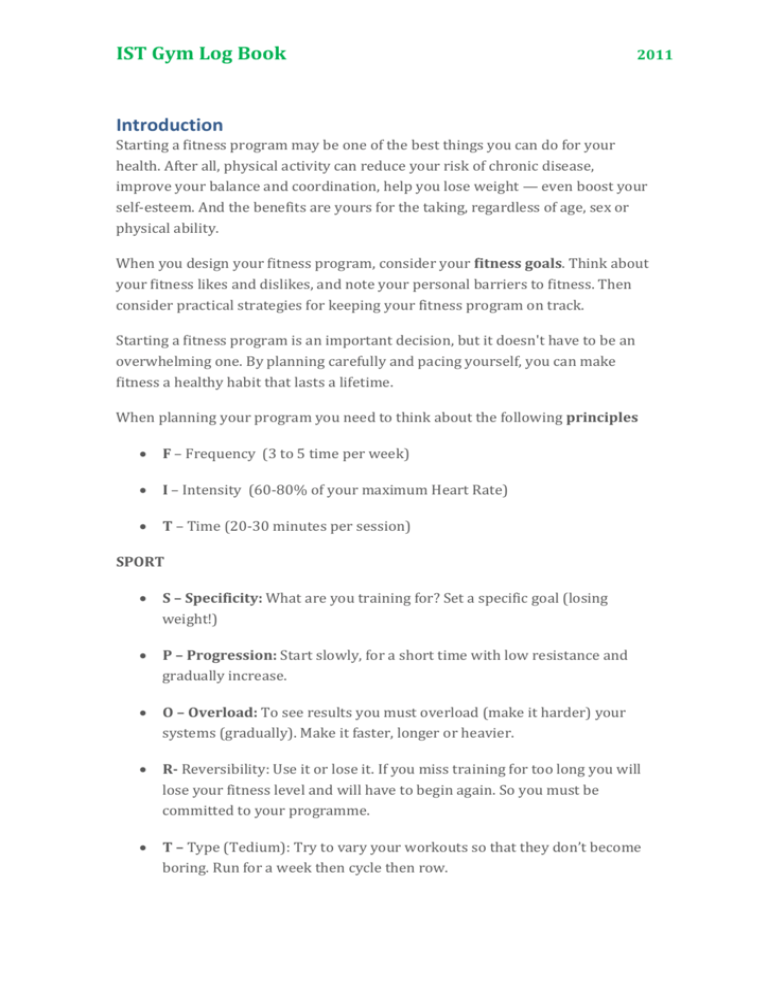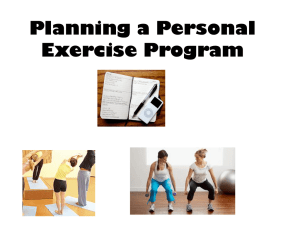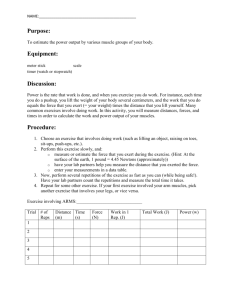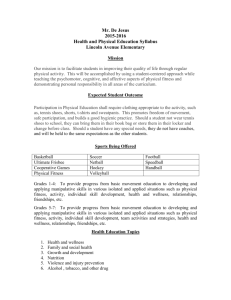Introduction
advertisement

IST Gym Log Book 2011 Introduction Starting a fitness program may be one of the best things you can do for your health. After all, physical activity can reduce your risk of chronic disease, improve your balance and coordination, help you lose weight — even boost your self-esteem. And the benefits are yours for the taking, regardless of age, sex or physical ability. When you design your fitness program, consider your fitness goals. Think about your fitness likes and dislikes, and note your personal barriers to fitness. Then consider practical strategies for keeping your fitness program on track. Starting a fitness program is an important decision, but it doesn't have to be an overwhelming one. By planning carefully and pacing yourself, you can make fitness a healthy habit that lasts a lifetime. When planning your program you need to think about the following principles F – Frequency (3 to 5 time per week) I – Intensity (60-80% of your maximum Heart Rate) T – Time (20-30 minutes per session) SPORT S – Specificity: What are you training for? Set a specific goal (losing weight!) P – Progression: Start slowly, for a short time with low resistance and gradually increase. O – Overload: To see results you must overload (make it harder) your systems (gradually). Make it faster, longer or heavier. R- Reversibility: Use it or lose it. If you miss training for too long you will lose your fitness level and will have to begin again. So you must be committed to your programme. T – Type (Tedium): Try to vary your workouts so that they don’t become boring. Run for a week then cycle then row. IST Gym Log Book 2011 Cardiovascular training (Aerobic): When training, the most important muscle to exercise is your heart! With a strong heart you can conquer just about anything as it ensures proper blood flow to all of your other muscles and allows them to be pushed to and past their normal limits. Therefore it is imperative that you train for the proper duration to give your heart a good workout. One of the best ways to do this is to train at intervals for a duration of at least 15 minutes up to 30 minutes. This can be applied to running, biking, swimming, rowing, jumping rope, elliptical trainer and stair master. One of the most important aspects of cardiovascular exercise is making sure that you are actually working your heart. You should know your Maximum Heart Rate (MHR) and your correct training zone to know if you are training at the right pace. Here are a few ways to figure your target heart rate. You can easily find your Target Heart Rate (THR) with this simple method. Subtract your age from 220 (226 for women) to calculate your MHR. Find your training zone below and multiply that number times your maximum rate. i.e. THR of 60% for a boy of 16 is 122.4 220-16 = 204 (204 * 0.6)= 122.4 Warm-up--- 40-50% for 5 minutes (should be able to carry on a conversation with someone) Healthy Heart Zone (Warm up) --- 50 - 60% of maximum heart rate: The easiest zone and probably the best zone for people just starting a fitness program. It can also be used as a warm up for more serious walkers. This zone has been shown to help decrease body fat, blood pressure and cholesterol. It also decreases the risk of degenerative diseases and has a low risk of injury. 85% of calories burned in this zone are fats! Fitness Zone (Fat Burning) --- 60 - 70% of maximum heart rate: This zone provides the same benefits as the healthy heart zone, but is more intense and burns more total calories. The percent of fat calories is still 85%. Aerobic Zone (Endurance Training) --- 70 - 80% of maximum heart rate: The aerobic zone will improve your cardiovascular and respiratory system AND increase the size and strength of your heart. This is the preferred zone if you are training for an endurance event. More calories are burned with 50% from fat. Anaerobic (High level training/ Sprint training)--- Above 80% of your maximum heart rate: The anaerobic zone is one which is used by top level sprinters and games players. It enables them to work at high levels/speeds for longer and helps improve the speed of recovery. This type of training can only be endured for short periods of time and can take place in the form of intervals. IST Gym Log Book 2011 Target Heart Rates for a 16 year boy: 50%= 102; 60%= 122; 70%= 143; 80% = 163 Weight Training Weight training can improve Muscular Strength, Muscular Endurance and Muscle Tone. Muscular Strength is the ability of a muscle to move an object or resistance. Muscular strength can be improved by putting stress on your muscles (lifting weights). You can lift fixed weights (multi gym) or free weights, which ever you choose will help. Weight Training Tips Do a single set of repetitions. Theories on the best way to approach weight training abound, including countless repetitions and hours at the gym. But research shows that a single set of 12 repetitions with the proper weight can build muscle just as efficiently as can three sets of the same exercise. So what's the proper weight? One that's heavy enough to tire your muscles after about 12 to 15 repetitions. You should be just barely able to finish the last repetition. Start slowly. If you're a beginner, you may find that you're able to lift only a few pounds. That's OK. Once your muscles, tendons and ligaments get used to weight training exercises, you may be surprised at how quickly you progress. Once you can easily do 12 repetitions with a particular weight, gradually increase the weight. Take time to rest. To give your muscles time to recover, rest one full day between exercising each specific muscle group. You might choose to work the major muscle groups at a single session two or three times a week — or plan daily sessions for specific muscle groups. For example, on Monday work your arms and shoulders, on Tuesday work your legs, and so on. For most people, short weight training sessions several times a week are more practical than are extended daily workouts. "You don't have to be in the weight room for 90 minutes a day to see results," says Edward Laskowski, M.D., a physical medicine and rehabilitation specialist at Mayo Clinic, Rochester, Minn., and co-director of the Mayo Clinic Sports Medicine Center. "You can see IST Gym Log Book 2011 significant improvement in your strength with just two or three 20- or 30minute weight training sessions a week." Weight training Do’s and Don’ts Do: Lift an appropriate amount of weight. Start with a weight you can lift comfortably 12 to 15 times. For most people, a single set of 12 repetitions with the proper weight can build strength just as efficiently as can three sets of the same exercise. As you get stronger, gradually increase the amount of weight. Use proper form. Learn to do each exercise correctly. The better your form, the better your results — and the less likely you are to hurt yourself. If you're unable to maintain good form, decrease the weight or the number of repetitions. If you're not sure whether you're doing a particular exercise correctly, ask a personal trainer or other fitness specialist for help. Breathe. You might be tempted to hold your breath while you're lifting weights. Don't. Holding your breath can lead to dangerous increases in blood pressure. Instead, breathe out as you lift the weight and breathe in as you lower the weight. Seek balance. Work all of your major muscles — abdominals, legs, chest, back, shoulders and arms. Strengthen the opposing muscles in a balanced way, such as the front of the shoulder and the back of the shoulder. Rest. Avoid exercising the same muscles two days in a row. You might work all of your major muscle groups at a single session two or three times a week, or plan daily sessions for specific muscle groups. For example, on Monday work your arms and shoulders, on Tuesday work your legs, and so on. Don't: Skip your warm-up. Cold muscles are more prone to injury than are warm muscles. Before you lift weights, warm up with five to 10 minutes of brisk walking or other aerobic activity. Rush. Move the weight in an unhurried, controlled fashion. Taking it slow helps you isolate the muscles you want to work and keeps you from relying on momentum to lift the weight. IST Gym Log Book 2011 Overdo it. Remember, completing one set of exercises to the point of fatigue is typically enough. Additional sets may only eat up your time and contribute to overload injury. Work through the pain. If an exercise causes pain, stop. Try it again in a few days, or try it with less weight. Forget your shoes. Shoes with good traction can keep you from slipping while you're lifting weights. Remember, the more you concentrate on proper weight training technique, the more you'll get from your weight training program. http://www.mayoclinic.com/health/weight-training/SM00028/NSECTIONGROUP=2 Claiming CAS hours If you would like to claim CAS hours for working out at the gym you must fill out and hand in the Gym Workout Log sheet. This sheet must include clear goals. The maximum number of hours you can claim each week is 4. IST Gym Log Book 2011








